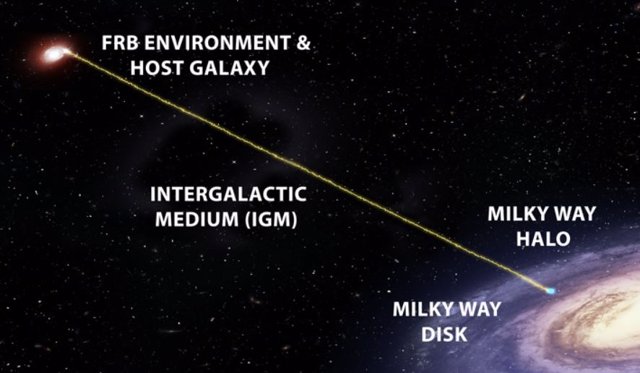
March 31 () –
By tracking mysterious cosmic FRB signals, astronomers have discovered that the Milky Way’s halo contains much less gas than previous models had predicted.
The radio signals used by the team – led by University of Toronto PhD candidate Amanda Cook – come from the astronomical phenomenon known as fast radio bursts (FRBs): enigmatic celestial objects that generate brief flashes of light waves. radio and are considered one of the greatest mysteries of astronomy.
Since an FRB simultaneously generates high-frequency radio waves (the equivalent of blue light) and low-frequency radio waves (the equivalent of red light), different colors of radio waves can be expected to reach the telescope at the same time. But that’s not what happens. As an FRB passes through the gas it slows down, more for high frequencies than for low frequencies. The result is a delay between the different frequencies or colors arriving at our telescope, effectively diffusing the signal from the radio burst in time.
Astronomers call this technique “scattering” and can use it as a tool to detect invisible gas throughout the cosmos.
“Using dithering to study the universe is like using your home heating bill to calculate what the weather must have been like during winter,” Cook says. it’s a statement. “In the same way that your heating bill tells you whether it was a harsh or mild winter, but not what the temperature was like on an individual date, the blobs we see allow us to infer the total amount of material the FRB signal has found on its journey from its origin to Earth. It just can’t tell us how that material was distributed along the way.”
“The key is that regardless of how the gas is distributed in front of the FRB, an FRB signal that becomes more smeared when it reaches our telescopes must be produced by an FRB that It’s further away like an expensive heating signal.”
In this case, Cook used the scattering method to measure the amount of gas present in the Milky Way’s halo, an “atmosphere” of the Milky Way that extends about half a million light-years in all directions.
Using FRB signals collected by the Canadian Hydrogen Intensity Mapping Experiment (CHIME) radio telescope, Cook and his team found that the Milky Way’s halo contains much less gas than previous models had predicted. The results were published in the Astrophysical Journal.
Although there have been previous studies that applied related techniques, this is the first time that halo gas has been measured using a large, uniform sample of FRBs, thanks to the CHIME telescope.











